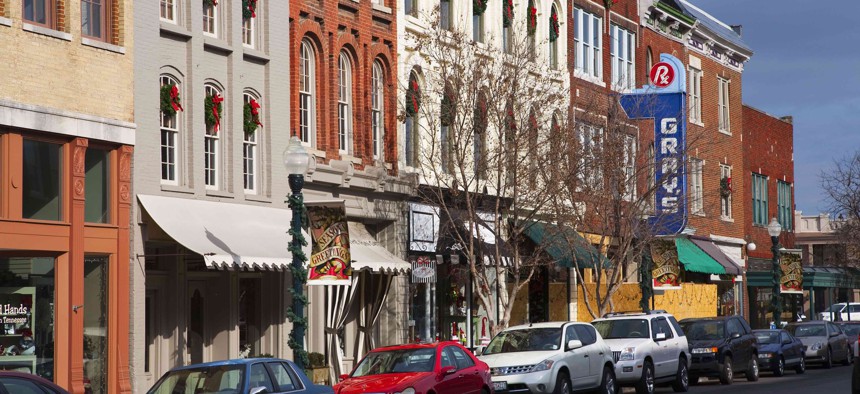The Economic Hotspots Outside of Downtowns

Grays Pharmacy and other stores in Franklin, Tennessee, a suburb south of Nashville. Joe Sohm/Visions of America/Universal Images Group via Getty Image
Development in and around cities is different than it was a generation ago. New research looks at the emergence of “activity centers,” asset-rich hubs peppered throughout metro areas.
Local officials and planners who focus too heavily on the vibrancy of downtowns might be missing crucial components of their region’s economic health, researchers from the Brookings Institution recently warned.
“After decades of suburbanization, activity does not concentrate in the same ways it once did,” the researchers wrote. “Metropolitan areas are no longer structured along a linear continuum, fanning outward from a distinct downtown to edgeless suburbia to rural countryside dotted with a few town centers. They instead contain constellations of asset-rich places, typically surrounded by housing-only developments or a mix of residential and commercial sprawl.”
The Brookings team, led by Tracy Hadden Loh, stressed the importance of “activity centers” where they found economic, physical, social and civic assets clustered within metropolitan regions. The activity centers can be traditional downtowns or suburban destinations where a disproportionate amount of jobs and other amenities are located.
“Given everything we’re going through with Covid, folks still have this big question about whether technology like Zoom and cloud computing has severed the connection between productivity and place,” Loh said in an interview with Route Fifty. “What we find is that, even in the age of digital abundance, agglomeration effects still exist, and that they’re very strong.”
The centers cover only about 3% of the land in metropolitan areas but account for about 40% of the jobs, the researchers found. The workers who are located there are more productive the denser the area is. Meanwhile, commercial real estate and housing in those zones is worth more than in the surrounding areas.
The centers are home to 83% of hospital beds, employ 90% of university staff, account for two thirds of museums and nearly half of the historic sites in metropolitan areas.
Activity centers also differ significantly from the surrounding areas when it comes to transportation and land use.
“The vast majority of metropolitan residents—in the vast majority of metro areas— live within three miles of an activity center, and this is even more true for people of color and low-income households,” the Brookings researchers found. The activity centers are more walkable and easier to reach through public transportation than nearby areas.
The concentration of people around activity centers means that they could be easily accessible by bike or by foot, the Brookings team added.
Loh said local officials and other leaders should focus on improving their existing activity centers rather than trying to create new ones, because incremental changes can have outsized effects in these economic hotspots.
She also pointed out that the fate of Black, Hispanic and Asian communities is closely tied to the decisions local officials make for existing activity centers, because they are so often close geographically. The right kinds of investments in activity centers can also benefit those communities, but handling growth poorly could lead to displacement and other harms for those racial groups, Loh said.
“It’s important for planners and practitioners … to be proactive in terms of thinking about operating within a ‘Do No Harm’ framework when proposing policy changes,” she said, “or even better yet proactively looking for opportunities to advance equity and inclusion [by] making sure that the existing communities that might be impacted have a stake in the changes.”
The full report, including maps of activity centers in 110 metropolitan areas, is available here.
Daniel C. Vock is a senior reporter for Route Fifty based in Washington, D.C.
NEXT STORY: Why Campaigns Have a Love-Hate Relationship With Their Signs






